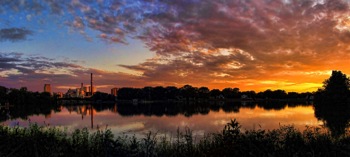
By Chad Johnson
David Watkins and other leaders of the Minnesota Association of Christian Home Educators (MACHE) faced a challenge as they planned April’s statewide convention. Horse whisperer Lew Sterrett’s educational sessions would require a corral, truckloads of dirt and temporary stalls. MACHE officials had to decide who to call among the three cities it uses in rotation — the Twin Cities, Duluth and Rochester.
“We agreed. Rochester is the place. If anyone can do it, they can,” said Watkins, conference director and MACHE board chairman.
And Rochester did. The Mayo Civic Center hauled dirt, fashioned a 70-foot-by-100-foot corral and built stalls. “They bent over backward to make sure everything was safe,” said Watkins.
MACHE officials discovered Rochester’s meeting virtues by accident several years ago when the association’s annual conference was pushed out of St. Paul by the NCAA Final Four and into the city that Mayo Clinic built.
Since then, Rochester has become a favorite of MACHE attendees, a break from the bustling but sometimes intimidating larger cities. “Our members like Rochester because it has become more of a getaway time,” said Watkins.
MACHE hopes to return to Rochester, but because its attendance is growing, it might have trouble doing so. The Mayo Civic Center, built in 1938 and expanded through the years, is almost too small for MACHE and is too small for many others. A study showed that Rochester lost 146 events in 2007-08 because the Mayo Center could not handle them.
A solution is in the wings as the city and its many backers, including the Mayo Clinic, prepare to ask the state to back a bond issue that would pay for half of a convention center expansion. The bond issue was approved last year by the state legislature but was eliminated by Minnesota’s governor. Brad Jones, executive director of the Rochester CVB, believes the project will be a go this time.
“We see it coming to fruition in the next 12 months,” said Jones.
The other half of the expansion would be funded by a 1 percent increase in lodging tax and a new 1 percent tax on food and beverage.
The project would nearly double the civic center, adding a 40,000-square-foot ballroom with 10,000 square feet of prefunction space on one level and breakout rooms on another.
The civic center now has a 7,200-seat arena, a 3,000-seat auditorium and an exhibit hall but no “true dedicated convention space,” Jones said. The expansion will solve that, providing the “higher-end, high-square-footage meeting center” that many seek, according to Jones.
Mayo Clinic brings millions to town
When it comes to tourism, Rochester is a city like no other. With a population of 105,000, it hosts 2.7 million visitors each year, “and the vast majority are here for the Mayo Clinic,” said Jones. Mayo is the city’s largest employer, with 38,000 staff. “It is our big driver,” said Jones.
But discard the image of patients hobbling around on crutches or spinning along in wheelchairs.
Half of the people who come to the Mayo Clinic are healthy and are at the clinic for physicals or other preventive care; the average patient spends only 30 percent of his time at the hospital.
Because Rochester’s visitation is steady and not as easily influenced by the economy, the hospitality industry is also strong, the city’s No. 2 employer.
The 2.5 blocks between the Mayo Clinic and the Mayo Civic Center is downtown’s major corridor. It is where the convention hotels are located, among them the historic 668-room Kahler Grand with its built-in, upscale International Hotel on the top floor; the 271-room Kahler Inn and Suites; the 203-room Rochester Marriott Mayo Clinic Area; and the newly refurbished 212-room Doubletree Hotel Rochester, the hotel closest to the civic center.
Downtown is “very much connected by a series of skyways, like St. Paul and Minneapolis,” said Jones. A subterranean link, a pedestrian subway, is lined with restaurants and shops. Thanks to those systems, the civic center is connected to just over 2,000 hotel rooms.
“The skyways and the connected hotel rooms are absolutely necessary for what we do,” said Matt Esau, director of sales for the Mayo Civic Center. “Our busiest times are the fall and the winter and in the early spring, when it is still cold here.”
Many visitors are well-to-do, well connected and seeking medical care at Mayo Clinic. It is not unusual to see a Hollywood actor, a country music star or a sheik lining up for appointments with the leading specialists at Mayo.
Those types of visitors have fueled downtown restaurants of many ethnic influences and upscale shops stocked with imports from other lands.
Plazas perk up downtown
Despite the obvious advantages during Minnesota’s long winter, the city’s skyways and subways can make the city seem devoid of life.
That has changed in recent years, thanks to downtown plazas paid for by downtown merchants, who voted to tax their businesses to fund the improvements.
Now a summertime music festival on Thursday nights is just one example of the downtown events that bring people out to party. Conventions make use of the plazas too, said Jones.
Downtown is not the sterile environment found 30 years ago.
“Twenty restaurants downtown offer outdoor dining and, last weekend there were 14 venues where you could hear live music,” said Jon Eckhoff, executive director of the Rochester Downtown Alliance. Downtown has become a destination, prompting more businesses to move to the urban center.
“The vitality is growing, and that creates an environment that is absolutely what I look for in a convention location,” said Eckhoff.
Mayo Clinic provides speakers
It is no surprise that medical groups are drawn to Rochester by the chance to hear speakers from the Mayo Clinic and tour its facilities. But the clinic holds possibilities for other meetings and conventions as well.
“The Mayo Clinic gives a lot of support for nonmedical meetings,” said Jones. “We can normally find a connection for most every group.
“We recently hosted the National Rocketry Association, a group of hobbyists who build and shoot rockets. We had a speaker from Mayo for them who is a doctor to the astronauts and could talk to the guys about the selection process for astronauts.”
Mayo has supplied speakers on healthcare reform, sports training, wellness, research projects involving agriculture products, even specialists in nonmedical areas such as public relations and social media.
Meeting planners might wonder whether the Mayo Clinic’s dominance makes it difficult to book conferences and conventions. “Right now, we can comfortably fit, any day of the week, 1,000 to 1,500 people into our market. Above that, it does create a bit of a challenge,” said Jones. If the convention center expands, he said, more hotels, now on the drawing board, will be built.
Patients typically visit Mayo Sunday through Thursday, so there is tremendous hotel availability on weekends. “That is the reason we have invested heavily in sports,” said Jones. Rochester six years ago began its push in the sports event market, and since then its staff in that area has grown from one to five.
Arts places are meeting spaces
Rochester’s well-educated workforce has resulted in an arts scene, which opens doors for potential off-site venues. One of the newest is Studio 324, a photography studio in an 1867 building downtown.
Shawn Fagan and his wife moved their business there and decided to make the building “work for us a little more” by opening the first-floor gallery for private events. Since they did so it has been well received. A credit union used it for a staff retreat; a major law firm held its staff appreciation dinner there. It was also the site of a dinner for graduating residents from the Mayo Clinic, three blocks away.
Another popular venue with an artistic mission is the Rochester Art Center, a “completely contemporary” structure built about six years ago on the Zumbro River, according to Emily Tweten, events manager. Its largest space is the Mayo Clinic Grand Lobby and Wells Fargo Atrium, where a wall of glass reveals the river, the city’s skyline and Mayo Memorial Park. The space seats 240 for dinners and about 400 for standing receptions. Galleries are on the two floors above the lobby, and the skyway system connects the center to the civic center.
“It is a very contemporary space, a clean slate,” Tweten said of the lobby. “You could get away with putting one red rose on each table and be done.”
Mayowood ties past and present
A venue that ties Rochester’s past and present, Mayowood is the former home of Dr. Charlie Mayo, The mansion that Dr. Charlie designed is a hodge-podge of architectural influences, open for tours and available for small special events. Its dining room handles small dinners or board gatherings; its lawn and gardens provide a break from the indoors.
Mayowood is a good place to get a better understanding of how members of Rochester’s most influential family lived, said James Olmsted, executive director of the History Center of Olmsted County.
“Every tour guide has their own thing that they know more about,” he said. “It is not a memorized tour where every guide says the same thing.” Tours often include stories they’ve been told by Mayo family members who live in the area.
The house has most of its original furnishings: the bust and other Napoleon artifacts that open the door to discussions of Dr. Mayo’s fascination with the French ruler; thousands of books that show the family’s passion for reading and knowledge; and posters of birds that indicate the love of nature.
The impact of the Mayos and the clinic they founded is not just a part of Rochester’s past, as any visitor can quickly discern. And the clinic, with its plans to grow, coupled with the expansion of the University of Minnesota at Rochester campus, give Rochester a “problem” that is the envy of towns of all sizes.
“Rochester has a significant advantage in the next 20 years in that both the health care and education sectors are growing,” said Eckhoff.
“Demand will grow because of the growth and that is almost certain to happen. It puts Rochester in a unique spot.”











